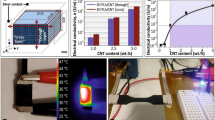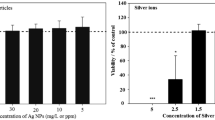A new method of obtaining of antimicrobial coatings based on segmented polyurethanes and silver nanoparticles (SNP) stabilized by an ionic liquid is proposed. The effect of silver nanoparticles on the structure and characteristics of the obtained materials have been studied using X-ray scattering, electron microscopy, infrared spectroscopy, differential scanning calorimetry, and the microbiological method of diffusion in agar. It is established that in the polymer matrix, SNPs with sizes from 7 to 19 nm are formed, and their size depends on the content of the stabilizer. The obtained nanocomposite coatings exhibit high antimicrobial activity against bacteria (S. aureus, E. coli) and fungi (C. albicans).






Similar content being viewed by others
References
M. M. Shameem, S. M. Sasikanth, R. Annamalai, et al., Mater. Today Proc., 45, 2536-2539 (2021), https://doi.org/10.1016/j.matpr.2020.11.254.
E. A. Lysenkov, O. V. Stryutskiy, Yu. P. Gomza, et al., Funct. Mater., 22, No. 1, 40-46 (2015), https://doi.org/10.15407/fm22.01.040.
E. A. Lysenkov, N. G. Leonova, and S. V. Zhiltsova, Theor. Exp. Chem., 55, No. 4, 250-257 (2019), https://doi.org/10.1007/s11237-019-09616-3.
M. Pagel and A. G. Beck-Sickinger, Biol. Chem., 398, No. 1, 3-22 (2017), https://doi.org/10.1515/hsz-2016-0204.
S. M. Imani, L. Ladouceur, T. Marshall, et al., ACS Nano., 14, No. 10, 12341-12369 (2020), https://doi.org/10.1021/acsnano.0c05937.
L. L. Wang, C. Hu, and L. Q. Shao, Int. J. Nanomed., 12, 1227-1249 (2017), https://doi.org/10.2147/IJN.S121956.
L. Guo, W. Yuan, Z. Lu, et al., Colloids Surf. A., 439, 69-83 (2013), https://doi.org/10.1016/j.colsurfa.2012.12.029.
J. D. Oei, W. W. Zhao, L. Chu, et al., J. Biomed. Mater. Res. Part B., 100B, 409-415 (2012), https://doi.org/10.1002/jbm.b.31963.
L. Cheng, S. Ren, and X. Lu, Polymers, 12, 407 (2020), https://doi.org/10.3390/polym12020407.
M. Villani, F. Bertoglio, E. Restivo, et al., Materials, 13, 4296 (2020), https://doi.org/10.3390/ma13194296.
A. R. Silva and G. Unali, Nanotechnology, 22, 315605 (2011), https://doi.org/10.1088/0957-4484/22/31/315605.
G. Kasi, S. Gnanasekar, Zhang K., et al., J. Appl. Polym. Sci., 139, No. 20, 52181 (2022), https://doi.org/10.1016/j.eurpolymj.2022.111087.
J. Wang, D. Dai, H. Xie, et al., Int. J. Nanomed., 17, 6791-6819 (2022), https://doi.org/10.2147/IJN.S393207.
M. A. Saleemi and V. Lim, Eur. Polym. J., 167, 111087 (2022), https://doi.org/10.1016/j.eurpolymj.2022.111087.
V. V. Shevchenko, A. V. Stryutsky, N. S. Klymenko, et. al., Polymer, 55, No. 16, 3349-3359 (2014), https://doi.org/10.10167/j.polymer.2014.04.020.
L. Rivas, S. Sanchez-Cortes, J. V. Garcia-Ramos, et al., Langmuir., 17, No. 3, 574-577 (2001), https://doi.org/10.1021/la001038s.
H. Xie, L. Wu, B.-G. Li, et al., Polymer, 155, 89-98 (2018), https://doi.org/10.1016/j.polymer.2018.09.033.
W. Xu, P. A. Ledin, V. V. Shevchenko, et al., ACS Appl. Mater. Interfaces, 7, No. 23, 12570-12596 (2015), https://doi.org/10.1021/acsami.5b01833.
N. Tian, X. F. Ni, and Z. Q. Shen, React. Funct. Polym., 101, 39-46 (2016), https://doi.org/10.1016/j.reactfunctpolym.2016.02.005.
S. Dawadi, S. Katuwal, A. Gupta, et al., J. Nanomater., 2021, 6687290 (2021), https://doi.org/10.1155/2021/6687290.
G. Yang, J. Xie, F. Hong, et al., Carbohydr. Polym., 87, No. 1, 839-845 (2012), https://doi.org/10.1016/j.carbpol.2011.08.079.
E. Lysenkov, O. Stryutsky, and L. Polovenko, 2022 IEEE 12th International Conference Nanomaterials: Applications & Properties (NAP), Krakow, Poland, 01-04 (2022), https://doi.org/10.1109/NAP55339.2022.9934675.
J. W. Rhim, L. F. Wang, and S. I. Hong, Food Hydrocolloids, 33, No. 2, 327-335 (2013), https://doi.org/10.1016/j.foodhyd.2013.04.002.
K. Luo, L. Wang, X. Chen, et al., Polymers, 12, 2631 (2020), https://doi.org/10.3390/polym12112631.
Z. Qin, L. Yunhui, and C. C. Kevin, Colloids Surf. B., 102, 345-360 (2013), https://doi.org/10.1016/j.colsurfb.2012.07.037.
Y. Meng, Nanomaterials, 5, 1124-1135 (2015), https://doi.org/10.3390/nano5021124.
C. Triebel, S. Vasylyev, C. Damm, et al., J. Mater. Chem., 21, 4377-4383 (2011), https://doi.org/10.1039/C0JM03487H.
M. Akbarian, M. E. Olya, M. Ataeefard, et al., Prog. Org. Coat., 75, No 4, 344-348 (2012), https://doi.org/10.1016/j.porgcoat.2012.07.017.
I. Mtimet, L. Lecamp, N. Kebir, et al., Polym. J., 44, 1230-1237 (2012), https://doi.org/10.1038/pj.2012.90.
B. S. Kim, J. S. Hrkach, and R. Langer, Biomaterials, 21, No. 3, 259-265 (2000), https://doi.org/10.1016/S0142-9612(99)00174-X.
Acknowledgements
The work was performed within the research on “Development of Innovative Technologies for the Creation of the Latest Silver-Containing Antimicrobial Nanocomposite Polymer Materials with Specified Multifunctional Characteristics for Special Purposes”, which is financed from the state budget by the Ministry of Education and Science of Ukraine. State registration number 0122U002326.
Author information
Authors and Affiliations
Corresponding author
Additional information
Translated from Teoretychna ta Eksperymentalna Khimiya, Vol. 59, No. 2, pp. 114-121, March-April, 2023.
Rights and permissions
Springer Nature or its licensor (e.g. a society or other partner) holds exclusive rights to this article under a publishing agreement with the author(s) or other rightsholder(s); author self-archiving of the accepted manuscript version of this article is solely governed by the terms of such publishing agreement and applicable law.
About this article
Cite this article
Lysenkov, E.A., Stryutsky, O.V., Klymenko, L.P. et al. Obtaining, Structure, and Antimicrobial Properties of Nanocomposite Coatings Based on Polyurethane and Silver Nanoparticles. Theor Exp Chem 59, 126–135 (2023). https://doi.org/10.1007/s11237-023-09772-7
Received:
Accepted:
Published:
Issue Date:
DOI: https://doi.org/10.1007/s11237-023-09772-7




